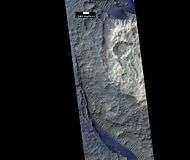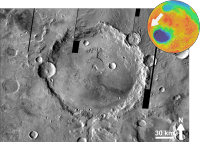Schaeberle (Martian crater)
|
Schaeberle Crater, as seen by THEMIS. | |
| Planet | Mars |
|---|---|
| Coordinates | 24°42′S 309°54′W / 24.7°S 309.9°WCoordinates: 24°42′S 309°54′W / 24.7°S 309.9°W |
| Diameter | 160 km |
| Eponym | John Martin Schaeberle, an American astronomer (1853-1924) |
Schaeberle Crater is a crater in the Iapygia quadrangle of Mars, located at 24.7° S and 309.9° W. It is 160 km in diameter and was named after John Martin Schaeberle, an American astronomer (1853–1924).[1] Impact craters generally have a rim with ejecta around them, in contrast volcanic craters usually do not have a rim or ejecta deposits. As craters get larger (greater than 10 km in diameter) they usually have a central peak.[2] The peak is caused by a rebound of the crater floor following the impact.[3] If one measures the diameter of a crater, the original depth can be estimated with various ratios. Sometimes craters expose layers that were buried. Rocks from deep underground are tossed onto the surface. Hence, craters can show us what lies deep under the surface.
Why are Craters important?
The density of impact craters is used to determine the surface ages of Mars and other solar system bodies.[2] The older the surface, the more craters present. Crater shapes can reveal the presence of ground ice.
The area around craters may be rich in minerals. On Mars, heat from the impact melts ice in the ground. Water from the melting ice dissolves minerals, and then deposits them in cracks or faults that were produced with the impact. This process, called hydrothermal alteration, is a major way in which ore deposits are produced. The area around Martian craters may be rich in useful ores for the future colonization of Mars.[4] Studies on the earth have documented that cracks are produced and that secondary minerals veins are deposited in the cracks.[5][6][7] Images from satellites orbiting Mars have detected cracks near impact craters.[8] Great amounts of heat are produced during impacts. The area around a large impact may take hundreds of thousands of years to cool.[9][10][11]
 Eastern edge of Schaeberle Crater showing landslides near top of image. Image taken by CTX camera (on Mars Reconnaissance Orbiter).
Eastern edge of Schaeberle Crater showing landslides near top of image. Image taken by CTX camera (on Mars Reconnaissance Orbiter). Enlargement of landslides from previous image of Schaeberle Crater. Image taken by CTX camera (on Mars Reconnaissance Orbiter).
Enlargement of landslides from previous image of Schaeberle Crater. Image taken by CTX camera (on Mars Reconnaissance Orbiter). Enlargement of channels in Schaeberle Crater. Right side of image is part of eroded wall. Left side is part of crater floor. Image taken by CTX camera (on Mars Reconnaissance Orbiter).
Enlargement of channels in Schaeberle Crater. Right side of image is part of eroded wall. Left side is part of crater floor. Image taken by CTX camera (on Mars Reconnaissance Orbiter). Dunes in a crater - HiRISE under the HiWish program.
Dunes in a crater - HiRISE under the HiWish program.
See also
References
| Wikimedia Commons has media related to Schaeberle (Martian crater). |
- ↑ "Gazetteer of Planetary Nomenclature | Schaeberle". usgs.gov. International Astronomical Union. Retrieved 4 March 2015.
- 1 2 http://www.lpi.usra.edu/publications/slidesets/stones/
- ↑ Hugh H. Kieffer (1992). Mars. University of Arizona Press. ISBN 978-0-8165-1257-7. Retrieved 7 March 2011.
- ↑ http://www.indiana.edu/~sierra/papers/2003/Patterson.html.
- ↑ Osinski, G, J. Spray, and P. Lee. 2001. Impact-induced hydrothermal activity within the Haughton impact structure, arctic Canada: Generation of a transient, warm, wet oasis. Meteoritics & Planetary Science: 36. 731-745
- ↑ http://www.ingentaconnect.com/content/arizona/maps/2005/00000040/00000012/art00007
- ↑ Pirajno, F. 2000. Ore Deposits and Mantle Plumes. Kluwer Academic Publishers. Dordrecht, The Netherlands
- ↑ Head, J. and J. Mustard. 2006. Breccia Dikes and Crater-Related Faults in Impact Craters on Mars: Erosion and Exposure on the Floor of a 75-km Diameter Crater at the Dichotomy Boundary. Special Issue on Role of Volatiles and Atmospheres on Martian Impact Craters Meteoritics & Planetary Science
- ↑ name="news.discovery.com"
- ↑ Segura, T, O. Toon, A. Colaprete, K. Zahnle. 2001. Effects of Large Impacts on Mars: Implications for River Formation. American Astronomical Society, DPS meeting#33, #19.08
- ↑ Segura, T, O. Toon, A. Colaprete, K. Zahnle. 2002. Environmental Effects of Large Impacts on Mars. Science: 298, 1977-1980.
